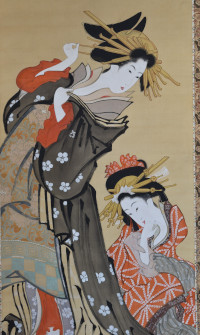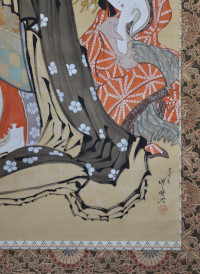Utagawa HIROSHIGE (1797-1858)
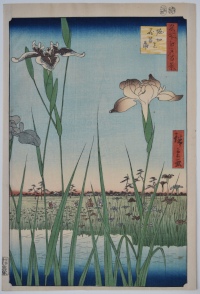
Click here to view image full size.
Horikiri no hana shobu, “Iris Garden at Horikiri” from Meisho Edo hyakkei, “Hundred Famous Views of Edo.” Published by Uoya Eikichi, 1856-58 (this being 1857). Horikiri village on the Arakawa River, north of Edo, was famous for growing irises, chrysanthemums, morning glory and azaleas for the Edo market. One of the most popular prints from the set. Provenance: Purchased from me in 2008.
Fine early impression. Fine colour and condition. Signed Hiroshige ga.
Status: Available
Watanabe SEITEI (SHOTEI) (1851-1918)
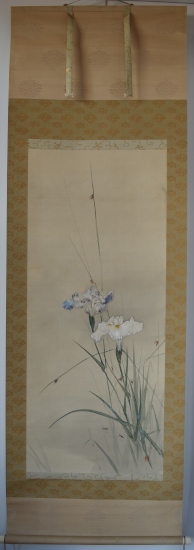
Click here to view image full size.
A large original painting, full colour on silk. Image size 47.25 x 20 in; 120 x 51 cms. Shows Japanese water iris with water striders. Seitei is best known as a kachoga (“bird and flower”) artist. He was technically brilliant showing realistic detail in a Japanese style but with Western sensibilities absorbed while living in Paris and he was, in fact, the first Nihonga artist to reside in Europe. A winner of many prizes during his life. Also published Seitei kacho gafu, 1890-91; Kacho gafu, 1903; Seitei kacho, 1916.
Signed and sealed Shotei. Very good condition. (This painting makes an excellent pair with the following offering although the mount sizes are slightly different.)
Status: Available
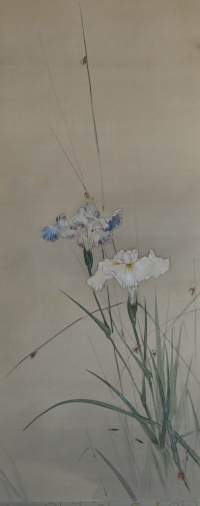
Click here to view image full size.
Watanabe SEITEI (SHOTEI) (1851-1918)

Click here to view image full size.
A large original painting, full colour on silk. Image size 47.25 x 20 in; 120 x 51 cms. Shows Japanese water iris with a snail. Seitei is best known as a kachoga (“bird and flower”) artist. He was technically brilliant showing realistic detail in a Japanese style but with Western sensibilities absorbed while living in Paris and he was, in fact, the first Nihonga artist to reside in Europe. A winner of many prizes during his life. Also published Seitei kacho gafu, 1890-91; Kacho gafu, 1903; Seitei kacho, 1916.
Signed and sealed Shotei. Very good condition. (This painting makes an excellent pair with the above offering although the mount sizes are slightly different.)
Status: Available
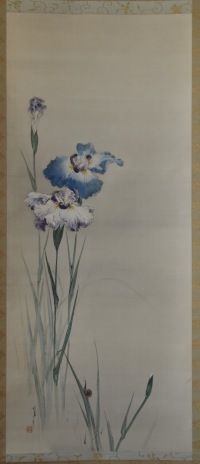
Click here to view image full size.
Hosoda EISHI (1756-1829)
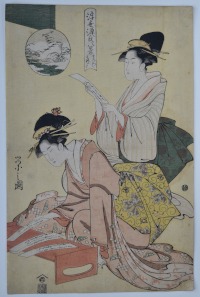
Click here to view image full size.
Two beauties examining tanzaku poetry cards from a set Ukiyo Genji hakkei, “Eight Views of Genji in the Floating World.” The designs stand alone but also form diptychs. This series compares scenes from the famous Tale of Genji novel written by the Lady Murasaki in the early 11th century with the Eight Views of Omi [Lake Biwa]. In the present case, Maboroshi rakugan (viz Katata rakugan, “Descending Geese at Katata”) is compared to chapter 41, Spirit Summoner, of the Tale of Genji where a poem composed by the Akashi Lady is in response to the grieving Genji’s poem after the nocturnal encounter with Murasaki which refers to the wild goose (aka Genji) having flown away. Published by Eijudo c 1797-99. Another impression is in the B.M., reg. no. 1931, 0427,0.8 and an impression is illustrated in Klaus J. Brandt, Hosoda Eishi, 1977, 119, no. 301. Provenance: Sold Sothebys, New York, 28/10/1980, lot 866.
Fine impression. Very good colour with yellow ground. Slight centre fold and very slight trimming, otherwise very good condition. Signed Eishi zu.
Status: Available
Kikugawa EIZAN (1787-1867)

Click here to view image full size.
An early complete 5-sheet (pentaptych) design being a mitate-e of a daimyo’s procession along Kugenuma beach with Enoshima island and Mt. Fuji in the background. Harugasumi hana iki retsu, “Journey in the Spring Mist.” The regional feudal lords (daimyo) were required every alternative year to travel to the capital of Edo. This was a deliberately costly affair and secured their loyalty as they had to leave their families in Edo. In this design young women replace the daimyo’s retinue. Published by Kawaguchiya Uhei, 1811-14. Its rare to find 5 or 6-sheet prints complete.
Fine impression and colour. Light album backing, otherwise very good condition. Signed Kikugawa Eizan hitsu.
Status: Available
Kitao MASANOBU (1761-1816)
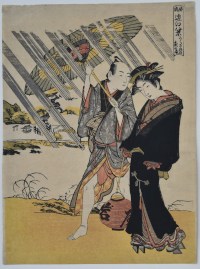
Click here to view image full size.
Shows a couple caught in a downpour, the man shielding his companion with an umbrella. They are on the shore of Lake Biwa, northeast of Kyoto. In the distance can be seen the famous ancient pine tree in the grounds of the Karasaki Shrine. An unsigned (few of Masanobu’s prints are signed or have publisher’s seals) chuban set Furyu Omi hakkei, “Fashionable Eight Views of Omi,” this being night rain at Karasaki. Wrote under the name Santo Kyoden. Was also a painter, and illustrator of his own novels while owning a tobacco accessory shop. Published c. 1783. Rare.
Fine impression and colour. Small backing paper at top two corners, otherwise fine condition.
Status: Available
Katsukawa SHUNSHO (1726-1792)
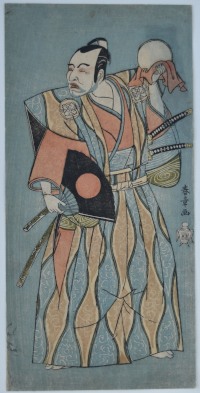
Click here to view image full size.
An hosoban showing the actor Nakamura Utaemon I as a samurai in nagabakama and kamishimo ceremonial dress as worn during the Muromachi period (1336-1392). He holds a fan and a globe. Shunsho was the pre-eminent exponent of the hosoban format. Published c 1770.
Fine impression. Unusual blue ground found on a few Shunsho designs. Slight discolouration on verso showing through, otherwise good condition. Signed Shunsho ga with the jar-shaped (tsubo) seal.
Status: Available
Okumura MASANOBU (1686-1764)

Click here to view image full size.
One of the most influential and innovative print designers, publishers and painters. He is also credited with inventing the hashira-e as well as being the first to use multiple-block printing. A wide hashira-e (habahiro hashira-e, 24 x 6 in; 61 x 15 cms) showing the actor Sanogawa Ichimatsu I. Masanobu designed a number of prints showing this popular actor who started the fashion for the hisobi pattern on his costume which is now called the Ichimatsu moyo. Published by Masanobu c 1741. Rare.
Fine impression. Hand-applied colour: yellow, light red and light orange. Slight fading, otherwise very good condition. Signed Hogetsudo shomei Okumura Bunkaku Masanobu shohitsu, “Truly published by Hogetsudo and true brush by Okumura Masanobu” with seal Tanchosai.
Status: Available
Utagawa KUNIYOSHI (1797-1861)
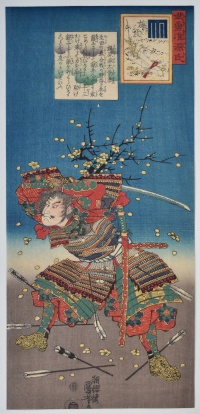
Click here to view image full size.
Chapter 32: Umegaye, “Plum brach” from an o-tanzaku set: Buyu nazorae Genji, “Heroic Comparisons for the Chapters of Genji.” Shows the Minamoto samurai Kajiwara Genda Kagesuye (1162-1200) fighting at Ikura-no-mori during the Genpai wars between the Taira and Minomoto clans. He has a plum branch stuck in his utsubo “quiver” in honour of his love Umegaye. The branch makes him an easy target for his enemies but he fights on regardless. Published by Ibaya Sensaburo, c 1843.
Very fine impression. Fine colour. Slightly trimmed at bottom, otherwise fine condition. Signed Cho-o-ro Kuniyoshi ga.
Status: Available
Utagawa KUNIYOSHI (1797-1861)
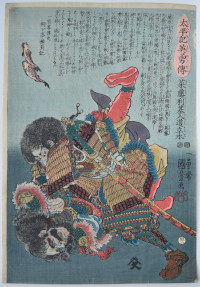
Click here to view image full size.
Saito Toshimoto nyudo Ryuhon in armour struggling with a Chinese brigand underwater. From the set Taiheiki yeiyuden, “Heroic Stories of the Taiheiki.” A history of the wars of the loyalist Nitta and Kusunoki families against the Ashikaga war-lords during the second quarter of the 14th century. But in fact the subject of this set of fifty prints is the civil war of the late 16th century. Censorship restrictions imposed in the 1840s prevented publishers from illustrating historical subjects from the Tensho era 1573-92 onwards, so the publishers circumvented this by slightly altering the names of the historical figures. Published 1848-9 by Yamamoto-ya Heikichi. Robinson S62.31. One of the best designs in the set.
Fine impression and colour. Very good condition. Signed Ichiyusai Kuniyoshi ga.
Status: Available
Tsukioka YOSHITOSHI (1839-1892)
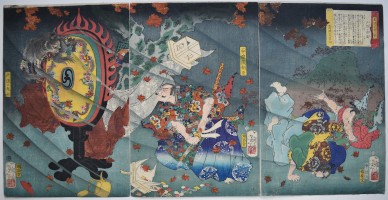
Click here to view image full size.
A triptych from a set Bidan musha hakkei, “Eight Views of Warriors’ Fine Tales.” This design Togakushi no seiran, “Clearing Weather of the Togakushi Mountains.” Princess Sarashina, who is actually a female oni called Momji, “Maple Leaves,” having transformed herself, is seen screaming from behind a giant drum and raising a high wind scattering maple leaves against Taira no Koremori Ason who draws his sword to kill her. Published by Sanoya Tomigoro, 1868.
Extremely fine impression of the earliest state. Fine colour. Slight marks on first sheet, otherwise very good condition. Signed Gekko Yoshitoshi hitsu.
Status: Available
Tsukioka YOSHITOSHI (1839-1892)
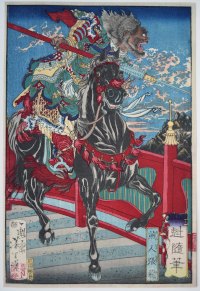
Click here to view image full size.
Shows the warrior Zhang Fei (Jap. Yokutoku) awaiting his rival Cao Cao on Changban bridge. Fei tricks his enemy into thinking he leads a vast army by dragging logs from a nearby forest causing a huge dust cloud. Cao Cao retreats. The story is from the Romance of the Three Kingdoms (Chi. Sanguo yanyi). From the set Ikkai zuihitsu, “Essays by Yoshitoshi.” (Ikkai was an early name of Yoshitoshi’s.) A set of thirteen prints published by Masadaya Heikichi 1872/3. A fine set.
Extremely fine impression and colour from the first edition. Fine burnishing on the horse. Most designs from the set have red seals in the margin and red seals over the signature. These were removed on later editions. Margins trimmed a little, otherwise fine condition. Signed Ikkaisai Yoshitoshi hitsu.
Status: Available
Tsukioka YOSHITOSHI (1839-1892)
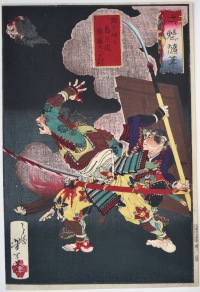
Click here to view image full size.
Shows the bloodied western army commander, Shima Sakon, having severed the head of Sato Daihachi, which flies through the air at Horagatoge Pass. Sakon lead an army of his Lord Ishida Mitsunari against the future Shogun Tokugawa Ieyasu at the battle of Sekigahara in 1600. From the set Ikkai zuihitsu, “Essays by Yoshitoshi.” (Ikkai was an early name of Yoshitoshi’s.) A set of thirteen prints published by Masadaya Heikichi 1872/3. A fine set.
Extremely fine impression and colour from the first edition. (There were no red seals on the first edition of this design.) Trimmed on black border at left, otherwise fine condition. Signed Ikkaisai Yoshitoshi hitsu.
Status: Available
Tsukioka YOSHITOSHI (1839-1892)
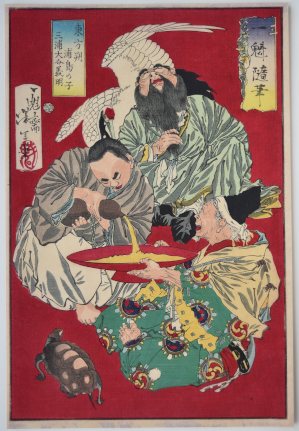
Click here to view image full size.
Shows Tobosaku (who stole the Peaches of Immortality), Miura Daisuke Yoshiaki (Lord of Kinugasa castle), and the son of Urashima Taro (who saved the sea turtle and was carried to the Dragon King’s Palace) drinking wine. From the set Ikkai zuihitsu, “Essays by Yoshitoshi.” (Ikkai was an early name of Yoshitoshi’s.) A set of thirteen prints published by Masadaya Heikichi 1872/3. A fine set.
Extremely fine impression and colour from the first edition. (No seals on the first edition.) Margins trimmed a little, otherwise fine condition. Signed Ikkaisai Yoshitoshi hitsu.
Status: Available
Utagawa KUNIYOSHI (1798-1861)
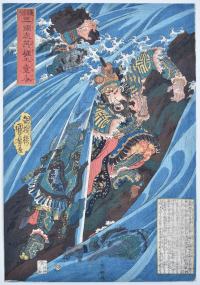
Click here to view image full size.
Cao Cao (Jap. Shuso) and Pang De (Jap. Hotoku) in the Han river during the battle with Guan Yu. From a set of Chinese warrior prints: Tsuzoku sangokushi eiyu no ichinin, “Heroes of the Popular History of the Three Kingdoms.” Published by Joshuya Kinzo, c. 1836. Robinson S10.8 (although only known as a key-block proof). Rare.
Superb impression. Very fine colour and condition. As the day it was printed. Signed Chooro Kuniyoshi ga.
Status: Available
Utagawa KUNIYOSHI (1797-1861)
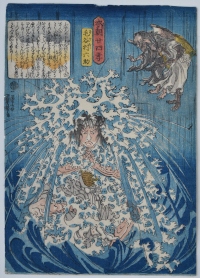
Click here to view image full size.
A fine chuban design showing Keyamura Rokusuke (aka Kida Magobee Muneharu), a famous farmer turned samurai and sumo wrestler of incredible strength, doing penance for seven days under the waterfall at Hikosan Gongen praying for his mother. Two Tengu watch from above. Waterfalls were one of the go-to-places to perform filial piety as they were considered to purify the soul in Shinto/Buddhist culture. From a set Honcho nijushiko, “Twenty-four Paragons of Filial Piety of our Country.” Published by Murataya Tetsu, 1843-6.
Fine impression and colour. Small nick out of top, otherwise very good condition. The signature Ichiyusai Kuniyoshi ga is on the extreme left edge and is often trimmed.
Status: Available
Utagawa Toyokuni II (1777-1835)
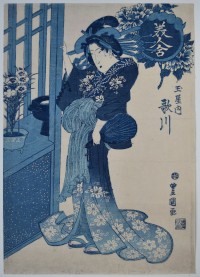
Click here to view image full size.
An aizuri-e (blue print) showing the courtesan Utagawa of Tamaya admiring a bowl of carnations. From a set Bijin awase published by Shimizu, c. late 1820s. These blue prints using the imported bero, Berlin blue (what we called Prussian blue), became popular during the 1820s to 1840s as the cost came down.
Fine impression and colour. Trimmed slightly, otherwise very good condition. Signed Toyokuni ga.
Status: Available
Keisai EISEN (1790-1848)
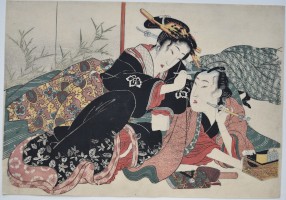
Click here to view image full size.
An amorous couple from an unsigned abuna-e (from abunai, risqué) set of twelve prints Keisai higo, “Secret Words of a Courtesan” published c. 1822-25. Although coming under the heading of shunga, each print is without any graphic details. She adjusts his hair with her hairpin while he smokes a pipe.
Fine impression, colour and condition. (Without centre fold, which is often encountered on this set.
Status: Available
Suzuki HARUNOBU (1724-1770)
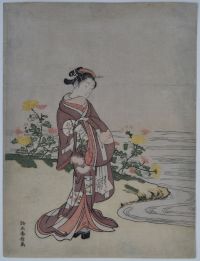
Click here to view image full size.
A beauty standing beside a stream where wild chrysanthemums grow. A mitate-e (parody) of Kikujido, the Chrysanthemum Boy, who was the favourite of the Chinese Emperor Mu (c. 950 B.C.). However, because of court jealousy, he was banished but had his exile eased by the Emperor who gifted him the ability to read sacred Buddhist texts. He became an immortal, spending his days surrounded by chrysanthemums and inscribing words of peace on the flowers’ petals. This is the second state: The first (private edition) is a calendar print with a signature (of an amateur) Kinga Ko and seal and has the year and its cyclical signs for 1766. These Harunobu calendar prints, printed in small numbers, were commissioned by wealthy individuals between c. 1764 and 1766 and so popular that they were published commercially. Rare.
Very good impression and colour Very minor edge soil, otherwise very good condition. Signed Suzuki Harunobu ga.
Status: Available
Kikugawa EIZAN (1787-1867)
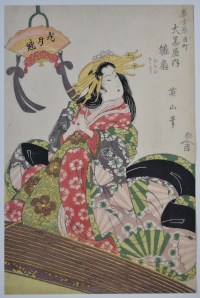
Click here to view image full size.
The geisha Hinaogi of the Daikokuya preparing to play the koto. She is adjusting the tsume (plectra) on her fingers that were used to pluck the strings. The title is enigmatic: It reads Ka getsu kai, “Harbinger of Moon and Flower” and if the character for “moon” is omitted it reads “oiran” (the highest ranking courtesan). Published by Enomotoya Kichibei, c. early 1830s. There is in fact a later copy of this print by Kunisada.
Fine impression. Excellent colour. Very good condition. Signed Eizan hitsu.
Status: Available
Katsushika HOKUSAI (1760-1849)
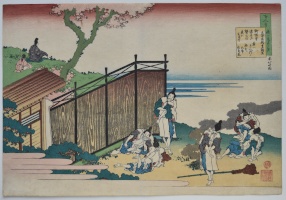
Click here to view image full size.
Hokusai’s interpretation of a poem by Onakatomi no Yoshinobu Ason (921-991). From an unfinished set: Hyakunin isshu uba ga etoki, “Pictures of One Hundred Poems by One Hundred Poets Explained by the Nurse.” The poems are from an anthology Hyakunin isshu, “One Hundred People, One Poem Each” compiled by the poet Fujiwara no Teika (1162-1241). The poet speaks of his love as being like the fire kept by the guards at the gate to the Imperial Palace: It burns hot only at night. There is actually some doubt that the poem can be attributed to Yoshinobu. Shows a group of off-duty Imperial carriage guards relaxing around the smoking embers of a fire. The poet with his servant is seen sitting on the distant hill. Published by Eijudo, 1835-36. A considerable number of original drawings exist for the set that were not turned into prints and are in various museums and private collections.
Fine impression, colour and condition. Signed Saki no Hokusai Manji.
Status: Available
Ryuryukyo SHINSAI (1764-1820)

Click here to view image full size.
An original painting, sumi and light colour on silk, 32 x 11 in; 81.3 x 28 csms. Shows three classes in Japanese society: Farmer’s wife, Priest and a Samurai, forced to shelter together at the entrance to a Shinto shrine from a sudden downpour of rain. Above, a rooster and hen also shelter. These birds were allowed to roam freely around Shinto Temples. Shinsai was one of Hokusai’s best pupils. Known for his fine surimono and paintings. Signed Ryuryukyo Shinsai with Ryuryukyo seal. In good condition.
Status: Available
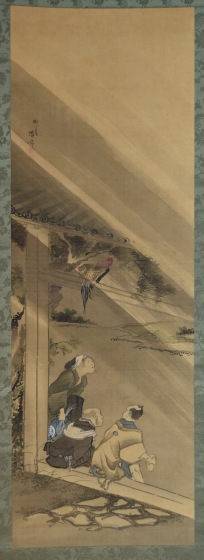
Click here to view image full size.
Ichiryusai HIROSHIGE (1797-1858)
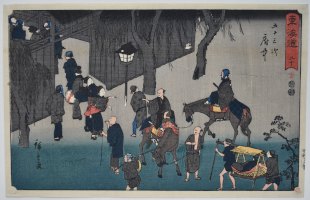
Click here to view image full size.
Fuchu from The Fifty-three Stations of the Tokaido published by Marusei, Maruya Seijiro, 1847-52. Called the Reisho Tokaido because of the angular style of Kanji used. Travellers coming and going at the entrance to the station. One of the best designs from the set. Provenance: Ex Hayashi collection with seal below title cartouche.
Fine impression and colour. Very good condition. Signed Hiroshige ga.
Status: Available
Hishikawa MOROSHIGE (Fl. 1684-1704)

Click here to view image full size.
An original painting, sumi and full colour on paper, 24 x 12 in; 61 x 30.5 cms. Shows a beautiful youth (a wakashu) dressed as a girl with his attendant servant. These youths (identified as male by wearing a sword) were arbiters of trend-setting kimono design. They are sometimes referred to as the “third gender,” and were sexually ambiguous being objects of desire to both adult men and women. Moroshige was the senior pupil of Hishikawa Moronobu, and, it is said, was the father of Furuyama Moromasa. Some toning of paper and slight loss of pigment, but all commensurate with a painting of this age. Otherwise good condition. Painted around 1700.
Signed Hishikawa Moroshige zu with seal Moroshige. A fine and interesting painting.
Status: Available

Click here to view image full size.
Utagawa KUNISADA (1786-1865)
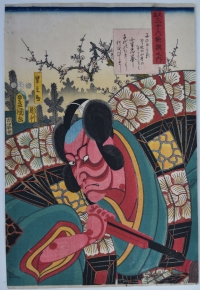
Click here to view image full size.
The actor Ichikawa Danjuro VIII as Arajishi Otokonosuke from a set Mitate sanjurokkasen no uchi, “An Imaginary Thirty-six Poets.” A famous early compilation; in this case the image is inspired by a poem of Mibu no Tadamine. Otokonosuke is usually depicted about to strike his adversary Nikki Danjo -who has turned into a rat – with an iron fan (leaving a red mark on the rat’s/Danjo’s head). Published by Iseya Kanekichi, 1852.
Very fine early impression. Fine colour. Very small binding holes, otherwise very good condition. Signed Toyokuni ga.
Status: Available
Utagawa KUNISADA (1786-1865)
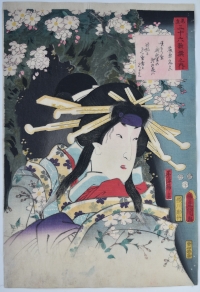
Click here to view image full size.
The actor Segawa Kikunojo III as the Spirit of the Komachi Cherry Tree from a set Mitate sanjurokkasen no uchi, “An Imaginary Thirty-six Poets.” A famous early compilation; in this case the image is inspired by a poem of Fujiwara no Motozane. The spirit is the courtesan Kurozome who appears to combat the evil plans of Sekibei (actually Otomo no Kuronushi) to cut the tree down. Published by Iseya Kanekichi, 1852.
Fine impression. Fine colour. Very small binding holes otherwise very good condition. Signed Toyokuni ga.
Status: Available
Toba HIROMARU (Active 1804-1818)

Click here to view image full size.
An original painting showing a parading courtesan. Sumi and colour on paper, 45.5 x 11.25 in; 115.5 x 28.5 cms. A rare artist of the Utagawa school. Probably a pupil of Utagawa Toyohiro. His extant paintings show a considerable talent with particularly attenuated faces. Another example is in the MFA, Boston, acc. no. 11.7369 as well as there having been two sold at auction: Christies, NY 16/9/2003, lot 153 and Bonhams NY 18/3/2015, lot 3010. Some minor marks and creasing, but otherwise good condition. Signed Toba Hiromaru hitsu. Seal unread.
Status: Available

Click here to view image full size.
Kawanabe KYOSAI (1831-1889)
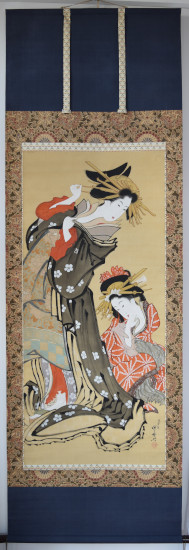
Click here to view image full size.
A large original painting, full colour on silk, image size 48 x 21.75 in; 122 x 55.25 cms. A draughtsman of great dexterity with a wild, often bizzare , imagination. Loved sake, sometimes painting under its influence. At an early stage studied under Kuniyoshi, then Maemura Towa and later Kano Chinshin before becoming an independent painter at 27. Adept at highly finshed paintings but also produced a large corpus of spontaneous paintings. Shows a standing courtesan with her kamuro. An homage to Hokusai whom he obviously admired.
Highly finished in places but also incorporating quirky elements of Hokusai’s style. Signed Hokusai hitsu-i (“Imitating Hokusai’s brush”) Shojo Kyosai. In very good condition with old double box with an untranslatable annotation on inside of lid comparing him to Hokusai. An important new discovery.
Status: Available
Toyohara KUNICHIKA (1835-1900)

Click here to view image full size.
A diptych showing the actor Ichikawa Danjuro IX as Kamakura Gongoro Kagemasa in the drama Shibaraku, “Just a moment.” The large sansho (three square) motif was the symbol of the Danjuro clan and is repeated around the border. In the background are peonies, also associated with the Danjuro clan. Published by Tanaka Katsuzo, 1878.
Fine impression, colour and condition. Signed Oju Toyohara Kunchika hitsu.
Status: Available
Utagawa KUNIYOSHI (1797-1861)

Click here to view image full size.
An o-tanzaku print, Yugao chapter from the fifty-four chapters of Genji, the Genji Monogatari. A tenth century romance written by Murasaki Shikibu. From a set Buyu nazoraye Genji, “Heroic Comparisons for the Chapters of Genji.” In this case showing Benkei creeping up on Ushiwaka on Gojo Bridge in Kyoto. The story relates how Benkei only needs one more blade to add to the 999 he has wrenched from samurai attempting to cross the bridge in order to fashion an invincible weapon. Benkei loses the fight and becomes Yoshitsune’s loyal retainer. Published by Ibaya Sensaburo, c. 1843.
Fine impression and colour. Very good condition. Signed Cho-o-ro Kuniyoshi ga.
Status: Available
Tsukioka YOSHITOSHI (1839-1892)

Click here to view image full size.
A triptych Taira Kiyomori hi no yamai no zu, “The Fever of Taira no Kiyomori.” Kiyomori’s wife, Niidono, dreams that the King of Hell, Ema, is coming for Kiyomori for his crime of burning the Rushana Buddha. His family gather around him and pray but to no avail. He dies on the 4/2/1181. Shows Niidono and her son beside a convulsed Kiyomori. Behind are visions of hell with Ema and figures who may have been Kiyomori’s victims. Published by Akiyama Buemon, 1883.
Fine impression, colour and condition. A lovely copy of this triptych. Signed Yoshitoshi ga.
Status: Available
Utagawa KUNIYOSHI (1797-1861)
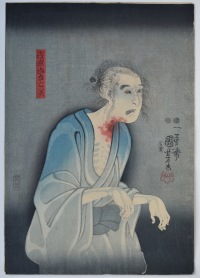
Click here to view image full size.
Ichikawa Kodanji IV as the ghost of Asakura Togo in the play Higashiyama Sakura zoshi, “The Story of Sakura of Higashiyama.” Based on historical events in 1653 with the characters’ names changed (Asakura Togo was actually Sakura Sogoro). The story tells of a village chief who was forced to witness the beheading of his sons before being crucified by the cruel samurai Lord Hotta Kozuki, after he had protested at the levy of unfair taxes. Sakura’s ghost returns to haunt Hotta’s castle. In fact the left sheet of a diptych. However, nearly always sold as a single sheet as the other side does not marry up, is undistinguished and was probably sold separately. Published by Sumiyoshi Masagoro, 1851. Beside the signature is the seal shita-uri, “low sale” meaning it was sold “under the counter” due to censorship laws prevalent at the time. This is the very rare first edition with the carver’s seal Hori Take, Yokokawa Takejiro, to the right of the publisher’s seal on the left. This was removed on later editions. One of the great ghost prints.
Fine impression, colour and condition with gum applied to the eyes (only found on the first edition).Signed Ichiyusai Kuniyoshi ga.
Status: Available
Utagawa HIROSHIGE II (1829-1869)

Click here to view image full size.
An original painting, full colour on silk, 37 x 14 in; 94 x 35.5 cms. The pupil of Hiroshige I who gave him the name Shigenobu. Adopted by Hiroshige in 1845 and married his daughter, Otatsu, on Hiroshige’s death. (Later divorcing her around 1865.) Shows a beauty cooling off on the prow of a boat beneath a full moon and the trestles of a bridge. (Probably the Ohashi over the Sumida River.)
In very good condition and possibly his best painting. Signed Hiroshige ga, seal unread.
Status: Available
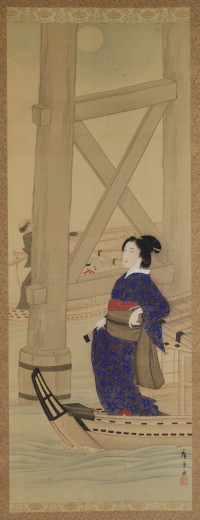
Click here to view image full size.
Yamamoto FUJINOBU (Active 1750-1770)

Click here to view image full size.
An original painting, full colour on paper, image size 32.25 x 7 in; 82 x 18 cms. Shows a parading courtesan with her kamuro. A painter and print artist whose prints were always published by Yamamoto Fusanobu giving rise to the theory that Fujinobu was a pseudonym of the publisher. Much influenced by Harunobu. His prints are extremely rare. Slight creasing, otherwise good condition. Signed Fujinobu ga with indistinct seal.
Status: Available

Click here to view image full size.
Kawanabe KYOSAI (1831-1889)

Click here to view image full size.
A fine original Kyosai painting, full colour on silk, 47.5 x 16.5 in; 121 x 42 cms. Shows Emma, the King of Hell, walking with and holding an umbrella above a courtesan while a ghoulish oni looks on wearing a costume of gunnera leaves. Emma-O is the Japanese Buddhist version of Yama, the Hindu god of death. It was he who assigned people after death to one of the states of reincarnation. He is shown with the headdress, robes and holding the staff of a Chinese judge. The preparatory drawing for this painting is illustrated in Kawanabe Kyosai, In Honour of 100TH Anniversary of His Death, published by Ukiyoe Ota Kinen Bijutsuken, 1989, no. 61, p. 60. Kyosai was a draughtsman of great dexterity with a wild, often bizarre, imagination. Loved sake, sometimes painting under its influence. At an early stage studied under Kuniyoshi, then Maemura Towa and later Kano Chinshin before becoming an independent painter at 27. Adept at highly finished paintings but also produced a large corpus of spontaneous paintings.
In very good condition. Signed Seisai Kyosai with Kyosai seal.
Status: Available
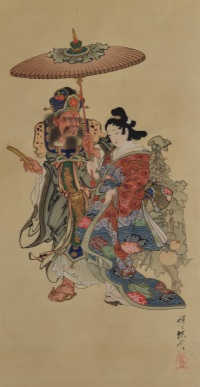
Click here to view image full size.
Utagawa HIROSHIGE (1797-1858)
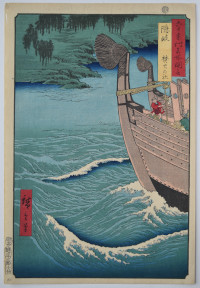
Click here to view image full size.
Oki Province, Takuhi Shrine. From a set of 69 prints [Dai Nihon] Rokujuyoshu meisho zue, “Famous Places in the Sixty-odd Provinces [of Japan]” published by Koshihei between 1853 and 1856, this being 1853. The prows of two boats near the island of Nishinoshima. A torii seen at the top of the print indicates the Takuhi Shrine, one of the most important shrines dedicated to the gods of the sea.
Fine impression and colour. Light album backing, otherwise very good condition. Signed Hiroshige ga.
Status: Available
Utagawa HIROSHIGE (1797-1858)
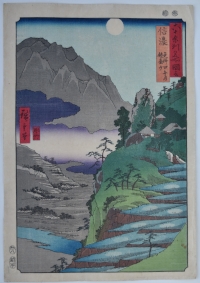
Click here to view image full size.
Shinano, Sarashina tagoto no tsuki, Kyodaisan, “Shinano [Province], the Moon Reflected in the Sarashina Paddy-fields, Mount Kyodai.” This was a popular destination for outings to view the multiple reflections. From a set of 69 prints [Dai Nihon] Rokujuyoshi meisho zue, “Famous Places in the Sixty-odd Provinces [of Japan]” published by Koshimuraya Heisuke between 1853 and 1856, this being 1853.
Fine, early impression. Fine colour and condition with large margins. Signed Hiroshige ga.
Status: Available
Utagawa HIROSHIGE II (1826-1869)
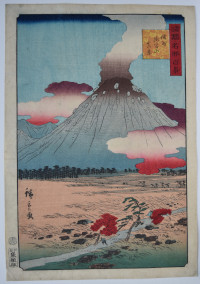
Click here to view image full size.
A view of a smoking Mt Asama, Shinano Province, from Shokoku meisho hyakkei, the “One Hundred Views of Famous Places in the Provinces.” Mt Asama is an active volcano which violently erupted in 1108. Subsequently there was another eruption in 1783 and since then there have been minor tremors. Published by Uoya Eikichi between 1859 and 1861 (this being 1859).
Fine impression, colour and condition. Signed Hiroshige ga.
Status: Available
